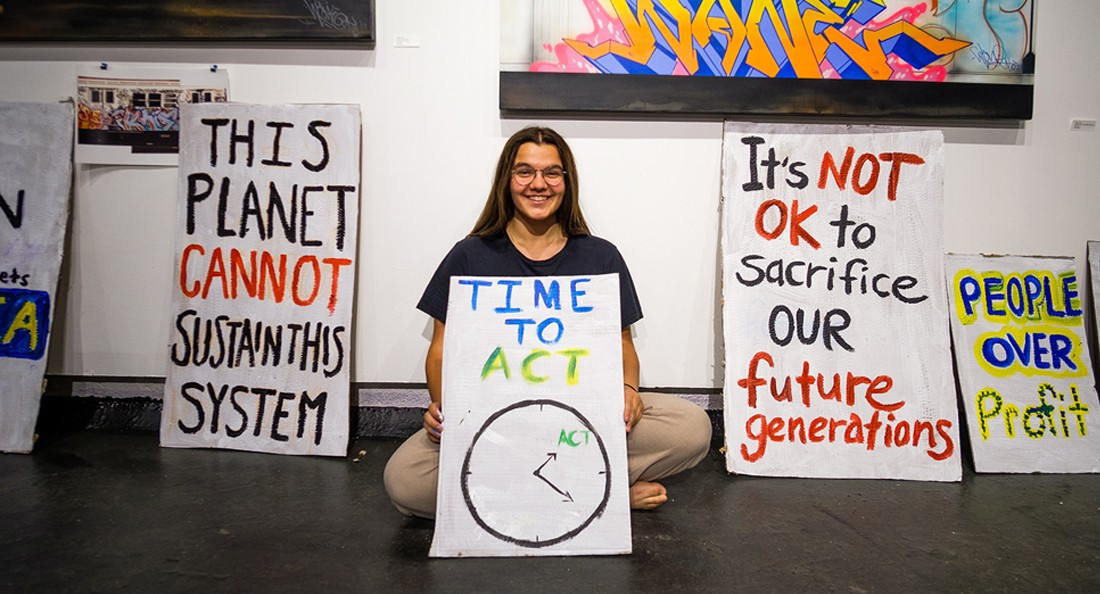The kids are (not) alright
Youth climate movements in Winnipeg are on the rise and stepping into their power
Winnipeg’s long, proud history of striking has been inherited by a new generation of organizers, leaders, and rebels: students. K to 12 students, more specifically.
Lena Andres joined the student climate strikes in Winnipeg in February, around the time that student strikers officially named their group: Manitoba Youth for Climate Action (MBYCA). She was a Grade 12 student at the time. Andres is the group’s main outreach point person, but she also takes on other tasks, as do many other members.
The group is one of many chapters in Fridays for Future, Greta Thunberg’s worldwide movement. Since Thunberg began striking for climate action in August 2018, students around the world have been walking out on Fridays to rally for climate change mitigation.
The first student strike in Winnipeg took place in December of 2018 outside of Winnipeg South Centre MP Jim Carr’s office and was led by students from École River Heights. Strikes have been held in Winnipeg at least once a month since February.
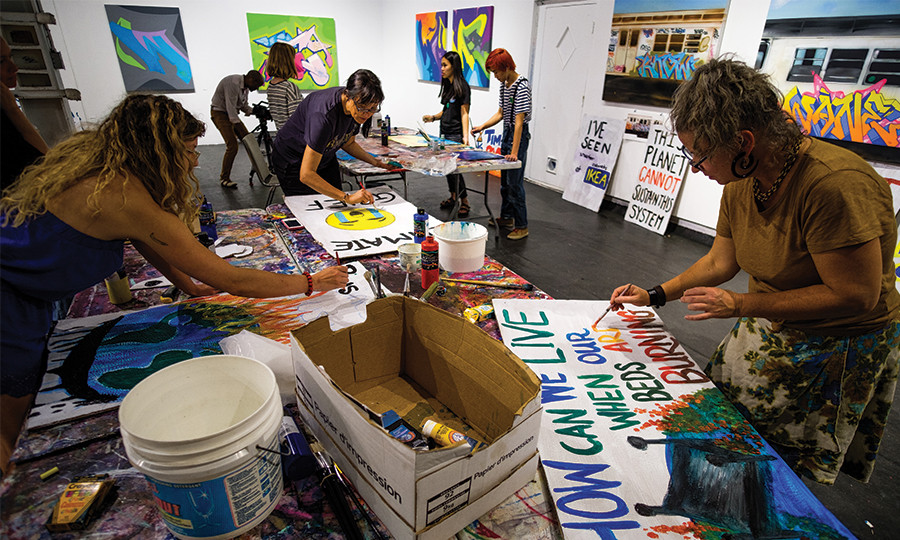
Kristen Andrews (right) brings a flavour of protest from a previous generation with her sign which reads "How can we live when our beds are burning," a twist on lyrics from a popular Midnight Oil song.
No age limit for entry
While the student strikes have largely been associated with youth and children in K to 12 programming, the movement is not limited to those under 18 years old.
“Technically,” Andres says, “a youth is defined by the Canadian government as a person who is 35 or under, so our youth group has university students in it, but our adult group also has university students in it. It’s not a matter of where you fit in. It’s where you can help the most.”
Andres says that organizing youth and adults has been “a lot easier” than expected.
“When we first started, it was 15 of us standing outside city hall, not really knowing what we were doing.” Now, MBYCA has a large social media presence and an adult ally group, Manitoba Adults for Climate Action (MBACA).
“We use a lot of social media, mainly Instagram. We almost have 2,000 followers, and that account’s only been around since the end of February, so that’s been a really powerful tool,” she says. “After each strike, we’ve seen an increase in our follower count of about 80 to 100 people.
“People scrutinizing us for being on our phones is quite funny to me, because we’re using our phones to plan a social revolution.”
Millennials have not given up
A meeting of Manitoba Youth for Climate Action members at Big Brothers and Big Sisters of Canada on Ellice Avenue.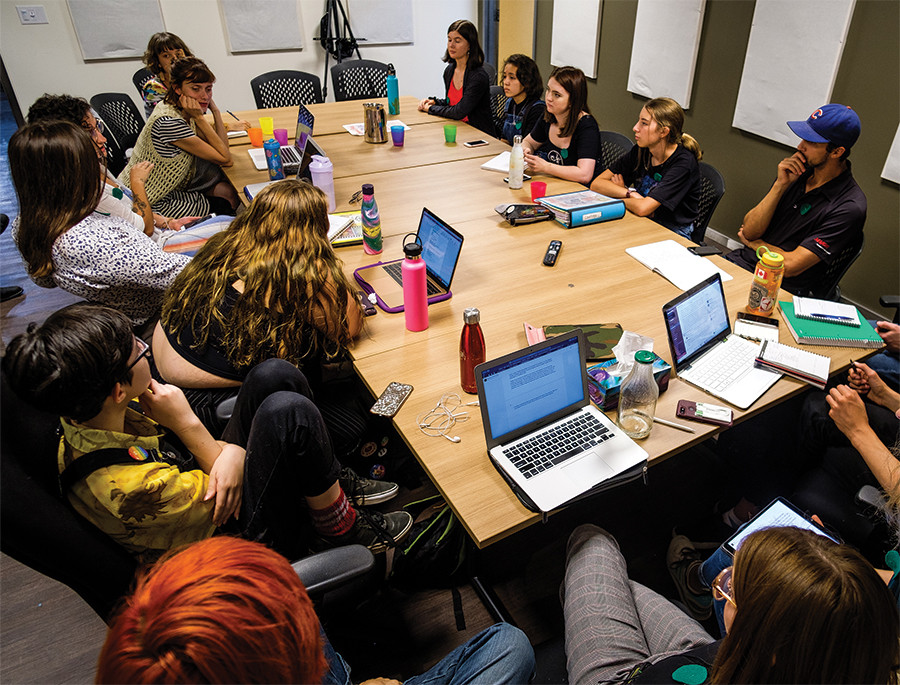
While youth organizing has found strength on Instagram, millennial-based organization Our Time – Winnipeg (OTW) has found canvassing, public art builds and organizing platforms like Slack useful for keeping people engaged and bringing up numbers.
Jenna Wilson, an organizer with OTW, says there’s a strong relationship between youth and millenial organizing.
“Our generation has grown up aware of the climate crisis on some level, and maybe even throughout our childhood and adolescence (we have) been quite concerned about the crisis and advocated for change and seen not a lot happening from older adults in the movement,” she says. “Now we’re kind of inspired by the younger youth who are really actively fighting for change.”
She says millennials “also maybe have a little more community connection and legitimacy in the eyes of the older generation, because we are working age and have more connection to corporate players as well.”
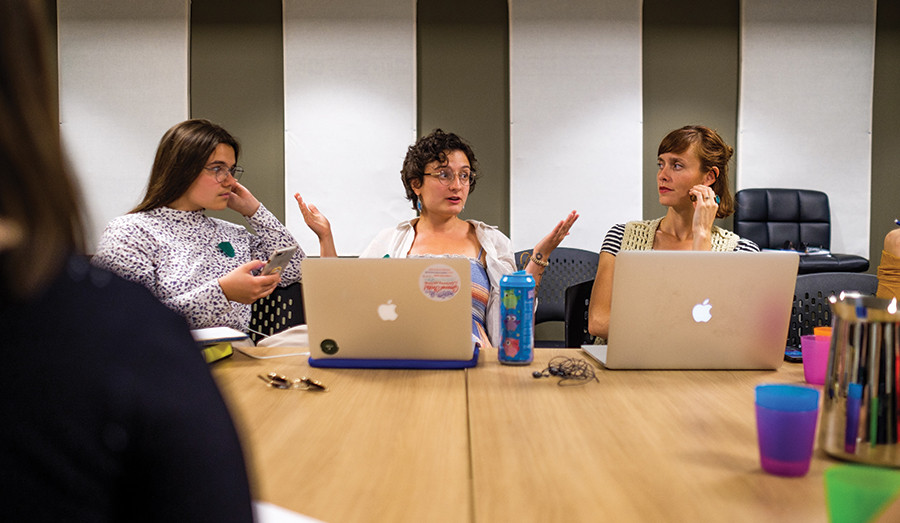
Lena Andres (left) and Meghan Mast (right) listen as Mandalyn Unger (middle) speaks during a Manitoba Youth for Climate Action meeting.
The election factor that no one names
OTW is one of many groups working together in Winnipeg’s climate activism scene, but it has some special abilities during election periods. Unlike many advocacy groups, especially youth groups, Our Time is a nationally and provincially registered third party.
“Without third-party status, you can’t legally endorse any candidates. You would get – maybe – even charged with collusion if you did. It really restricts what you can do financially with regards to advertisement,” Wilson says.
“Recently, Our Time Canada has endorsed 13 candidates across the country who we consider champions for the Green New Deal. We believe that if they are elected, they will work across party lines and run with this grassroots campaign towards climate justice.
“We are more than willing to work with any candidate from any party, so long as they identify with our core values and our desire for a Green New Deal.”
Lack of third-party status severely limits what an organization can say during an election period. Unless every candidate or no candidate has commented on a particular subject, like a Green New Deal, non-third parties are prohibited from publicly discussing the subject.
While many groups opt out of this status for a variety of reasons, Wilson says Our Time “feel(s) that we’re at a time where it’s imperative that we get some political action behind the climate movement.”
But Our Time still puts a lot of work into outreach to civilians in addition to politicians.
With regards to the upcoming Global Climate Strike, Wilson says that since “Our Time is focused on the post-secondary level, we’re going to spread the word within our respective canvases and try to set up meeting places by each institution for students to meet up before the strike.”
Andres says that having accessible interaction points is important when working with a demographic that cannot vote and feels widely ignored by politicians.
“People discount youth so much, and it’s hard, because even as a 17-year-old, I’m trying very hard not to look at somebody who’s in Grade 7 and say ‘oh, what do they know,’” she says.
Andres says that successful engagement is all about making sure that the group is willing to have an open mind and reaching out.
“That’s really what’s made our group locally and nationally so successful. We’re taking people in, and we’re all unified by our fear and anxiety about our future as a collective,” she says.
Andres says the amount of advocacy work that youth have had to take on indicates some major problems in the Manitoban and Canadian political climate.
“It’s astounding to all of us that adults who are in positions of power and have the ability to change this aren’t making those changes,” she says “That’s been very heartbreaking in a lot of different ways.”
“People keep saying that we’re just doing our job. No, this is not my job. I’m doing it because I have to, and I’m doing it because I want to protect people.”
Tell Them What We Want, What We Really Really Want
A sign that reads "THIS PLANET CANNOT SUSTAIN THIS SYSTEM" dries on a table at the Graffiti Gallery on Higgins Avenue.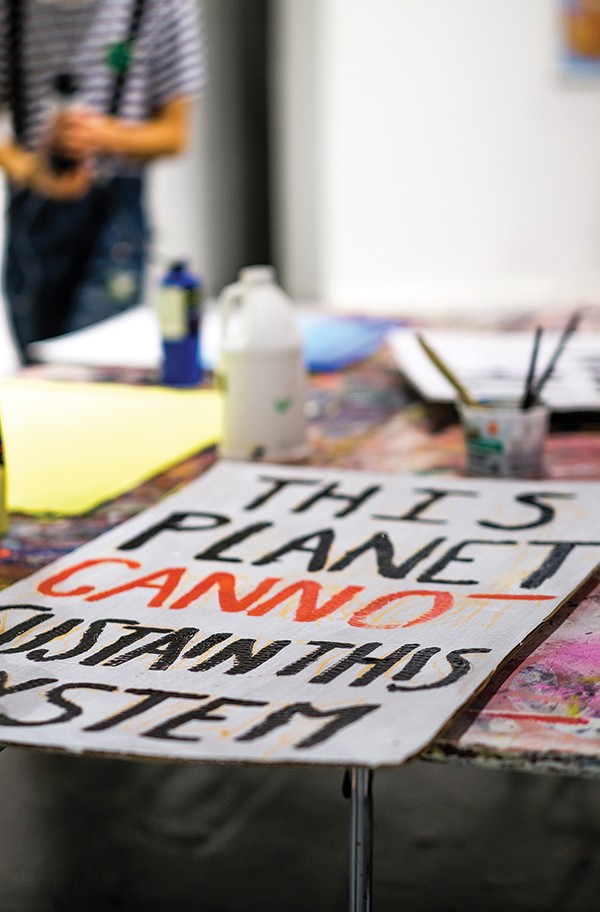
MBYCA is not unspecific in their demands from people in power. Climate Strike Canada has a list of seven demands from
governments:
• Bold Greenhouse Gas Emissions Reduction Targets
• Separation of Oil and State
• A Just Transition
• Environmental Rights
• Rights of Indigenous Peoples
• Conservation of Biodiversity
• Protection of Vulnerable Communities
It is the responsibility of each chapter of climate strikers in Canada to refine those demands into requests that are specific to their provincial and municipal governments. In Manitoba, for example, a separation of oil and state does not mean more hydro development or the privatization of hydro.
Andres says that specifying their demands has helped MBYCA better develop communication with people, community groups and businesses in Winnipeg.
Greta Thunberg declared Sept. 20 through 27 as a global week of action, and MBYCA has plans for each day, starting with a nation-wide die-in on Sept. 20.
“So at the same time across the country, every single person who’s at a climate strike is going to be dropping to the ground for seven minutes to symbolize our seven demands to show that we’re literally dying from the climate crisis. But on Sept. 20 globally, there is a global climate strike happening,” Andres says, which will involve over 2 million students walking out of class.
She says that from Sept. 21 to 26, Winnipeg’s week of action will involve a lot of viral videos and challenges. These will build up to Sept. 27, the national general strike for climate.
“On the 27th, we strike for everybody, because we’re all going to be affected,” she says. “It’s going to be our biggest action yet, and we’re hoping that it will be the tipping point for revolutionary activity that’s actually putting climate first in any political agenda.”
She encourages everyone to walk out from noon to 5 p.m. and join the rest of the strikers at the Manitoba Legislative Building. Those unable to attend can wear a green fabric circle in support of the strike and hold climate dialogues in their work or study spaces.
The youth are starting to change, are their institutions?
She notes that universities and colleges have not been as supportive as they could be, given the urgency of the strike’s demands.
Professors at Canadian Mennonite University announced the strike with their syllabi and are not enforcing absentee penalties to those who miss class on Sept 27. Some are requiring students attend the strike for class. Andres says this is way to recognize that “it's (a student’s) right to go strike for (their) future,” and that it is unfortunate that the University of Winnipeg has not been so engaged.
“You can say as much as you want that the university is here to nurture growth and promote learning and make the world a better place, but it’s not, because right now, universities and colleges are about making money,” she says.
Wilson says she would like to see more mental health support from institutions who employ or serve young organizers.
“I find that a lot of people in our generation are really overwhelmed with the climate crisis and really need that mental health support, and that could mean just a willingness and openness to talk about these feelings that the climate crisis brings up for people,” she says, “as well as being open to having more conversations about striking and organizing and having a little more leeway for students and employees who want to participate in this kind of action.”
Léanne Marchildon (right) and others cut out green felt circles that have become a symbol of the environmental youth movement. Rilke Cuthbert paints a protest sign that reads "I've seen smarter cabinets at IKEA."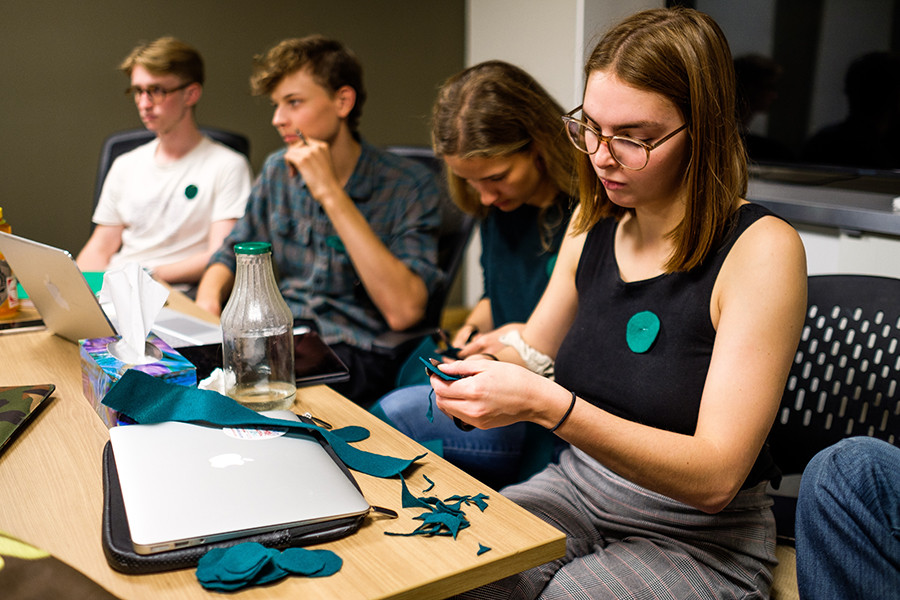
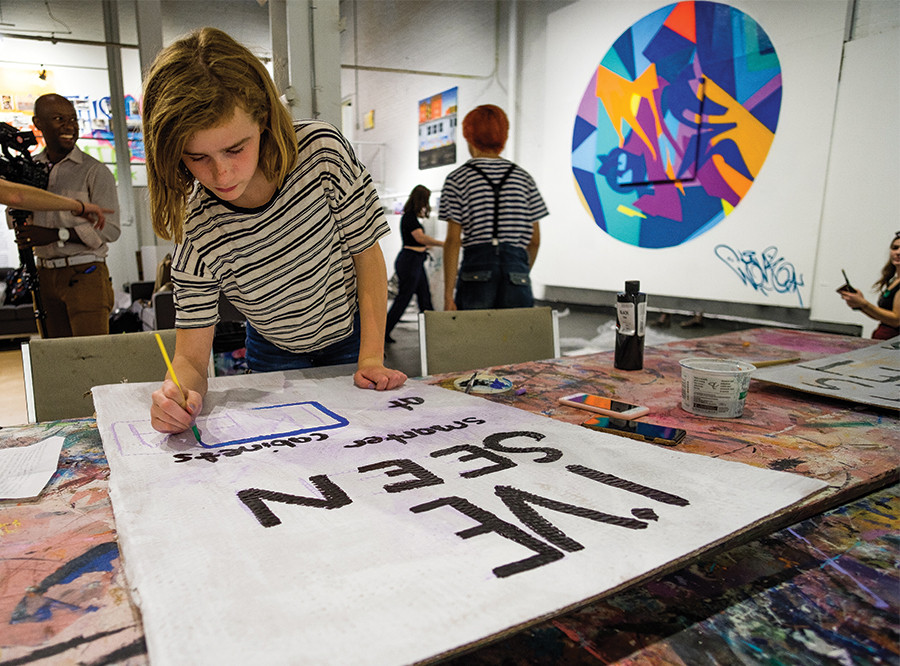
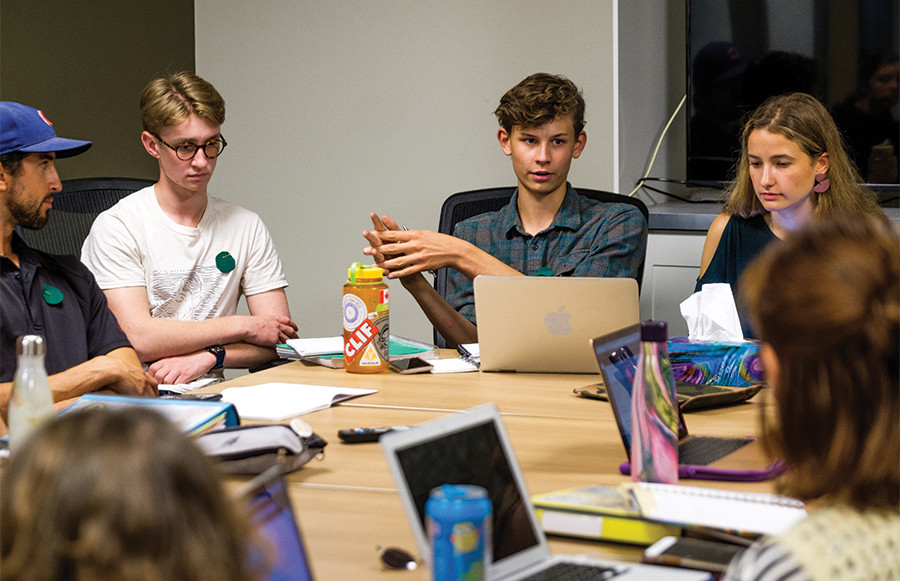
Cole Osiowy (middle) speaks during a meeting of Manitoba Youth for Climate Action.
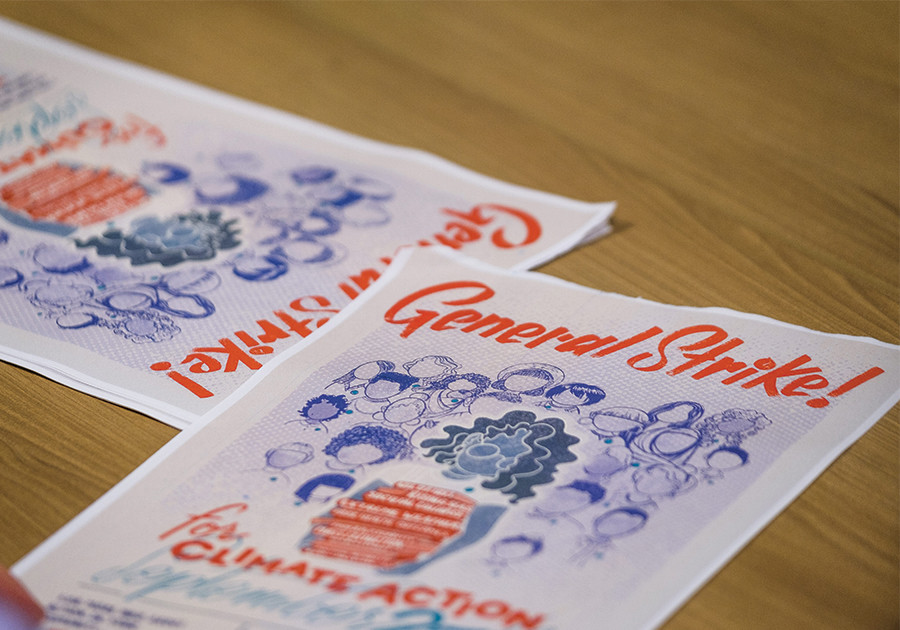
Climate action posters on the table at a meeting of Manitoba Youth for Climate Action.
Published in Volume 74, Number 3 of The Uniter (September 19, 2019)

